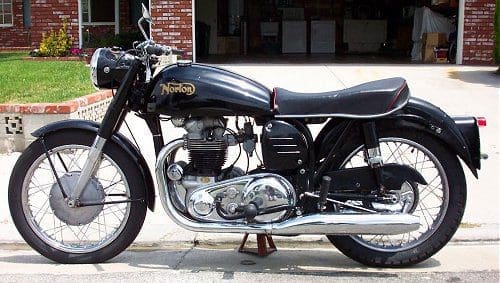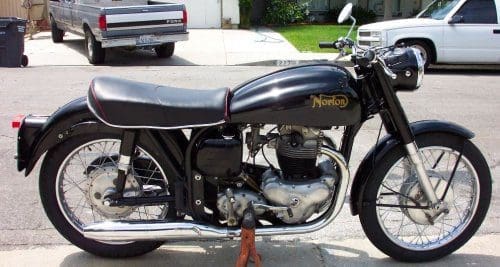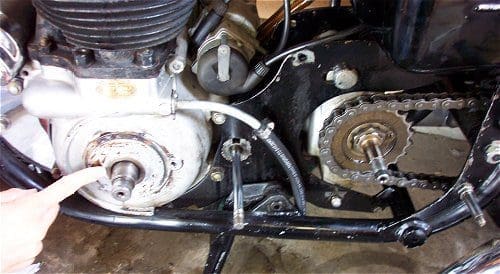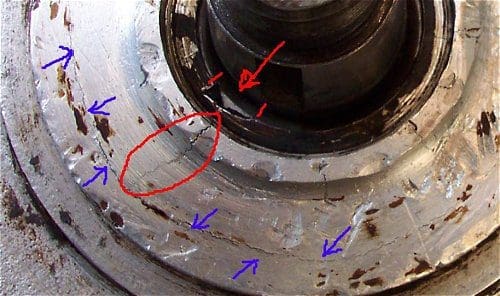Jim Algar’s Dominator Diary start here: the first (and hopefully not the last) of a sporadic, irregular series of reports, updates, musings, questions, tirades, victories and defeats as an American neophyte takes on his first classic British bike…
Chapter One
Wherein I immerse myself in all things Norton, and my newly-acquired Dominator suddenly reveals feet of clay (well… crankcase of aluminum).
When I had decided it was time to have a classic British bike, I intended to buy a non-runner. Rusted, dented, stained and showing its age; it didn’t really matter to me, because I’m one of those who absolutely enjoys the hours in the workshop with tools in hand, and I looked forward to a total nut-and-bolt rebuild of whatever bike came my way. (After all, had I not maintained and then eventually rebuilt my 1969 Austin Healey Sprite? Purchased new, when I was but a slip of a lad? With electrics by Lucas, don’t you know!?).
I had only one real requirement, which was that the bike be more or less complete. Oh, and no basket cases; I wanted the enjoyment (and learning experience) of disassembly, starting with a bike that was at least sitting on its own wheels. I didn’t want to sort through somebody’s cardboard boxes of ill-assorted bits, including the washing machine motor that somehow ended up amongst the gears and sprockets.
So I had sort of settled on a maximum dollar figure that I was willing to spend on a complete but non-running example. And I did end up spending that amount; but as it turned out I got a lot more bike than I thought I would. Call it luck or fate; whichever, it brought (by way of eBay) a very nice, running 1956 Norton Dominator 99 to live with me.

After rolling it out of the back of the van, I stood around with my wife, daughter and son as we all ‘oooh-ed and ahhh-ed’ over it. Curious neighbors came over, offering sundry comments.
‘Is that a Triumph?’
‘I had a bike something like that when I was in school.’
‘Are you really going to ride that thing?’
‘Aren’t you a little old to be owning a motorcycle?’
‘Excuse me, have you gone completely off your rocker?’
Nice people all, my neighbors, but I knew it would be pointless to explain. Bikes are in your blood… or they’re not.
Well, I thought, let’s start it up. Tap open, choke, tickle the Amal. Kick. Kick. Kick… and it’s ALIVE! It also puked out the obligatory gout of oil onto my driveway. Welcome to the world of wet sumping. Clutch in, toe up the gear lever (new mantra: on the right, one up and three down, on the right, one up and three down…). Let out clutch, and down my street I go. U-turn, and up my (very short) street I go. U-turn, go, U-turn, go. Well, it only took me 57 years, but I’m now the proud owner of a British motorcycle. A quick spurt of acceleration up my driveway, into the garage, hit the cut-out button… and my Dominator is safe and sound in its new home.

But wait: what of my desire for the total nut-and-bolt experience? This bike is in too good a shape, I think (Hah!), to need anything more than a few quick tasks and some continuing maintenance. What to do?
Well, I can consider those few tasks. The one thing the seller of the bike mentioned, which I could certainly address, is the tendency for the primary case to fill with oil. Some of this must be wet sump pump-out, I assume, but it continues all the time the bike is running. The seller suspected a leaking crankshaft oil seal, a diagnosis with which I concurred. Hey, says I, where are my tools?
So a quick call to Les Emery at Norvil Motorcycles and some miscellaneous bits and pieces, including the all-important oil seal, are winging their way over the Atlantic. Meanwhile, I get to work pulling the primary case. Off comes the outer case. (Don’t you love it when people make it sound so simple? We’ve just skipped entirely over wrestling off the exhaust, not to mention struggling with all the footrest ironmongery and the brake pedal).
As I was saying, off comes the outer case, whereupon I make my acquaintance with The World’s Largest Rubber Band, Norton’s clever (?) method of sealing the primary case. I think they must have worked as intended from the day the bike left the factory until the first time that somebody opened the case and then over-tightened that big central nut. Distortion… leak… oh, well. Will the owner of the completely straight, undistorted Norton primary cover please contact the Guinness Book of World Records? Thank you.

The inner case doesn’t really have to come off to change the oil seal, but in my desire to truly get acquainted with my bike, and to gauge its true condition, I pull it anyway. The oil seal comes out through the simple expedient of drilling two very small holes in the steel body of the seal and using two small wire hooks to grapple it out. So far, so good, I think. Uh…. actually, no. More like ‘Hey, Pandora, come over here and open this box for me!’

Examining the drive side of the crankcase, I am dismayed to discover that the area around the crankshaft oil seal resembles the surface of the moon… all dimpled and cratered. Two possibilities come to mind; that the primary chain broke at some point in the past and hammered the case during its (hopefully brief) thrashing, or that some Neanderthal had been at the cases with a ball peen hammer for some misguided reason. This does not bode well.
But wait (he exclaimed), worse is in store. An even closer examination shows cracks; radial cracks emanating outward from the crankshaft opening, and the beginning of a circular crack at just about the distance of the crank roller bearing OD. Hmmm (says I), was I saying something about ‘nut and bolt’ rebuild?

So that’s it, then. The consensus of opinion among RealClassic folk who’ve taken a look at some photos of the cracks – opinions with which I heartily concur – is that my running Dominator just graduated to being a non-runner. Oh, sure, I could slap everything back together with a new oil seal, and ride the bike for a while (these cracks have obviously been some time in developing), but when it lets go – notice when, not if – it surely would do so with an extensive, and expensive, bang.
Am I disappointed? No, not really. It would have been nice to have had a chance to ride the bike for a while before getting down to the re-building, but as I said at the start, I actually had been intending to get a non-runner…which is now exactly what I have. And the price I paid would have been fair for a non-running Dominator in much worse shape than this one (I think you’ll agree that the rest of the bike, apart from its crankcase flaw, is in very good nick.) Rather than an onerous chore, I approach the prospect of tearing into the bike was pleased anticipation.
So, expect Chapter Two – although not, I think, anytime soon. First things first, and first I have to decide which path take about the crankcase cracks; replace or repair? A set of used cases could probably be found with some patient searching and jumble sale trawling – or eBay mining- but when Norton went to a crank-mounted alternator in 1958, they changed the cases, so 1957 is the last year I can use, which means we’re talking almost-50-year-old parts. What additional horrors might await me in another set of cases?
And of course there’s the factor of maintaining originality. Norton engine numbers and frame numbers match – L 14 67803 in my case, if we want to get anorak about it – and although I’m not going to make a fetish of it, it would be nice to keep my Dommi as original as possible. So what about repair, then?
(Side note: here in the States an anorak (as an item of clothing) is a parka, which means we’ve no equivalent of the other meaning of the word as the personal idiosyncrasy that we all exemplify so proudly).
Anyway, a couple of transAtlantic phone calls to Les Emery at Norvil again have been encouraging. Eminently repairable, says Les; they’ll machine away the entire circular area in question and weld in a new section using aircraft-grade aluminum (sorry, aluMINium). So, with digital camera in hand, I’m ready to embark on the process of taking my Dommi to pieces, whereupon I shall lovingly bubble wrap and package the crankcase for its voyage back to the Mother Country. And while the folks at Norvil are at it, I might as well have them bead-blast the cases. Which means I really should polish the timing cover while it’s off… and the black coating on the cylinders is getting a bit thin… and what about the chipped paint on the frame… and after all, that front mudguard is the wrong one.
Oh, no, what am I letting myself in for? Is the road to bike restoration addiction? Is my bank manager about to become my best (or worst) friend? Is there a 12-step program for folk such as us?
Stay tuned.
People To Speak To
(Couldn’t find a URL for Motorcycle Addicts Anonymous, sadly. TP)



